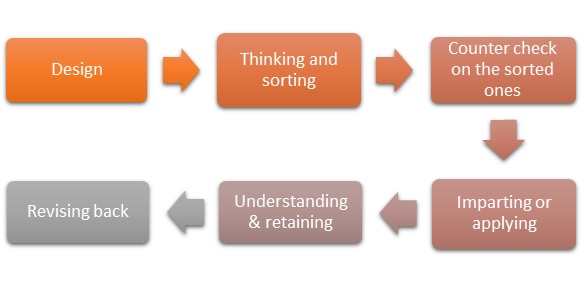- Business Concepts ›
- Human Resources (HR) ›
- Bloom's Taxonomy
Bloom's Taxonomy
Definition, Importance & Example
This article covers meaning & overview of Bloom's Taxonomy from HRM perspective.
What is meant by Bloom's Taxonomy?
Bloom’s Taxonomy is a hierarchical representation of how to understand and remember a concept or any novel thing. Bloom's Taxonomy in short analyses and defines the relation between what and how a tutor or teacher frames a concept and how he or she imparts that to his or her disciple.
Learning is not as easy as it sounds. It needs a lot of analysis and evaluation before it is ready to be addressed to the learner. First it needs to be designed, then it has to be crafted and analyzed where the main key words get sorted out, then the analyzed portion has to be evaluated on the basis of which it has to be imparted which the person understand sand then tries to remember and retain. It is also applicable for a person himself / herself to use Bloom's Taxonomy to understand a concept, it is not always restricted to a tutor trainee relation.
Three Models of Bloom’s Taxonomy
Bloom’s Taxonomy hierarchical model consists of the following three classifications:
1. Cognitive Domain (Based on Knowledge): It consists of Knowledge, Comprehension, Application, Analysis, Synthesis & Evaluation
2. Affective Domain (Based on Emotions): Receiving, Responding, Valuing, Organizing, Characterizing
3. Psychomotor Domain (Based on action): Perception, Set, Guided response, Mechanism, Complex overt response, Adaptation, Origination

Importance of Bloom's Taxonomy
With the competition increasing all over the world now a days, being a good learner and be able to adjust and grasp concepts easily is a necessity. The corporate world is always on the toes to introduce and reskill its employees. With digitization crawling into each and every aspect of the business world, Bloom’s taxonomy has got a very important role to play in today’s era as training and development have been one of the major concerns today in all the organizations. There are various types of training on the job, off the job and technological based training methods to improve employee skills. The common aspect being how to design these training modules and systems so that the objectives with which these training sessions are arranged turn out to be fruitful. For every training session, training objectives need to be defined first which gives the trainers insight about what they need to train and how they would be able to align those objectives to the goals, for trainees they will get an insight about what they are going to be trained upon so they can prepare themselves for that. These objectives mark the first step of Bloom's Taxonomy model i.e. design or create. Then what exactly has to be trained comes in the part of analysis, which then needs to be evaluated. Then the part of applications starts where the trainee starts applying the concepts or methods, tries to understand and follow them and remembers them, which is eventually followed by a revise back step.
Advantages of Bloom's Taxonomy Model
Certain advantages of the Bloom's Taxonomy model are:
1. Gives a simple layout structure for a learning process.
2. Has wide applications in business arena, especially in training and development field.
3. Can be applied to even a very small learning process like that of a learning process of a child at kindergarten stage.
Disadvantages of Bloom's Taxonomy Model
Certain drawbacks of this model are:
1. May be rejected by many organizations, there is no system of how successful the learning.
2. May be too simple to follow for some.
Example of Bloom's Taxonomy
Let us take an example of how to train a set of employees with good team management skills. To start with we need to have an objective which would be – at the end of the training session the employees would be able to effectively manage teams with various foreign clients at their respective geographic locations where they are allotted the projects. Then what type of skills they need to know to handle a team, then evaluating whether any other things to be put in and then the trainees would be trained which they would try to understand, remember and practice.
Hence, this concludes the definition of Bloom's Taxonomy along with its overview.
This article has been researched & authored by the Business Concepts Team which comprises of MBA students, management professionals, and industry experts. It has been reviewed & published by the MBA Skool Team. The content on MBA Skool has been created for educational & academic purpose only.
Browse the definition and meaning of more similar terms. The Management Dictionary covers over 1800 business concepts from 5 categories.
Continue Reading:
What is MBA Skool?About Us
MBA Skool is a Knowledge Resource for Management Students, Aspirants & Professionals.
Business Courses
Quizzes & Skills
Quizzes test your expertise in business and Skill tests evaluate your management traits
Related Content
All Business Sections
Write for Us